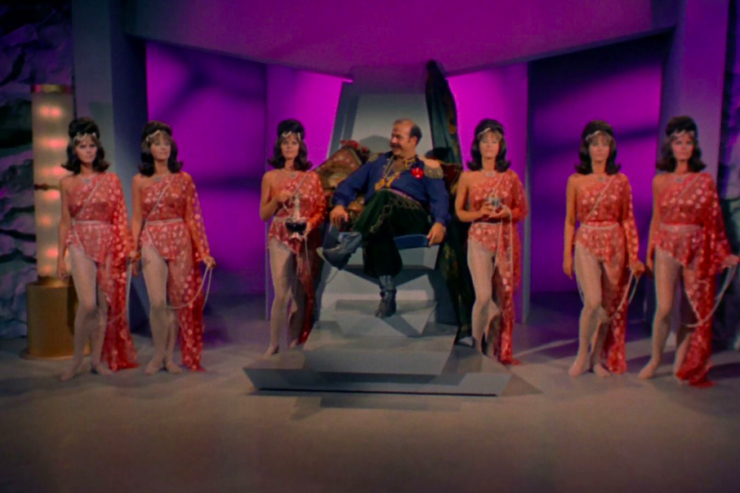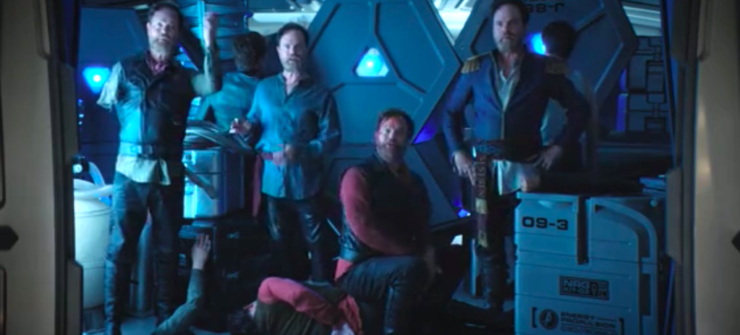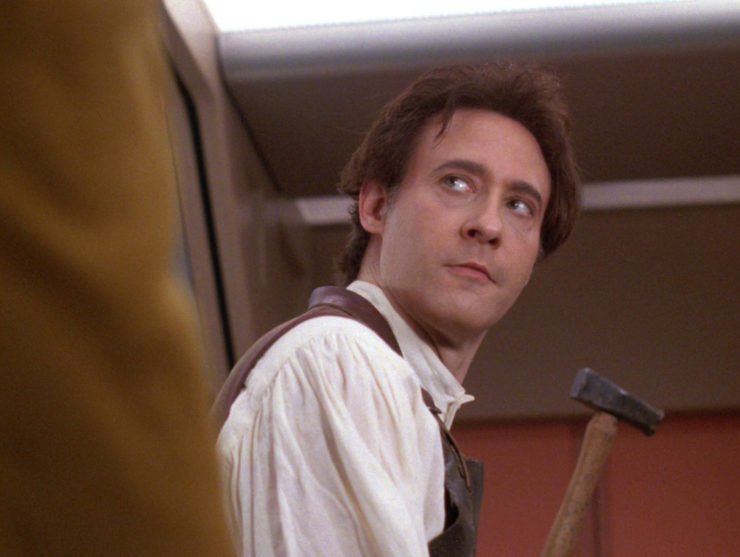The best thing about the twist-ending of Short Treks “The Escape Artist” isn’t just that it’s hilarious, or that it makes us think about Harry Mudd in a brand new way. No, the real best thing is that the new short might also subtly suggest that Harry Mudd could have a more direct link to the creation of Mr. Data in The Next Generation than anyone previously realized. It might sound like a stretch, but hear me out.
Big spoilers ahead for Short Treks’ “The Escape Artist.”
In the final scenes of “The Escape Artist,” we learn Harry Mudd hasn’t escaped alt all, but has instead been captured and brought to Federation justice for a variety of space crimes. Except, of course, it’s not really Harry Mudd. His latest con is all about using a seemingly endless supply of android duplicates who genuinely believe they are Harry Mudd, and letting those guys get captured instead. But where did he get the technology? And should this tech even exist at this point in Trek history?
The answer to the second question is easier than the first. Because, yes, android tech like this totally exists in the 23rd century, but they were almost never made by humans exclusively. Since the seventh episode of the first season of the original Star Trek—”What Are Little Girls Made Of?”—the 23rd century has been replete with androids who look human-ish. In fact, in that episode, there was even a successful android duplicate made of Captain Kirk. But “The Escape Artist” isn’t referencing those androids; writer Mike McMahan (yep, that’s the guy who is going to be writing Lower Decks) is clearly making a call-back to the second Harry Mudd episode from the original Trek—“I, Mudd”—in which Harry Mudd is surrounded by different android duplicates who eventually turn on him.

Technically this is less of a call-back and more of a call-forward, since the Harry Mudd seen on Discovery is running around about a decade before the events of “I, Mudd.” So what’s the deal? Has Mudd has this tech the whole time, and if so, what could this have to do with the androids we see in The Next Generation, like Data?
Here’s my theory: Harry Mudd didn’t invent the tech that made Data possible, but he set-up a chain of events that did.
It seems really unlikely that Harry Mudd invented the technology to create android duplicates of either himself or of other people. No, he clearly ripped-off whatever android maker he’s using from someone else, and it’s probably from the planet he ends-up on in “I, Mudd.” In that episode, Mudd tells Kirk and Spock that he got stuck on that android planet (also called Mudd) after their last encounter in “Mudd’s Women.” But we all know that Mudd lies, and it seems like Discovery is positing that Mudd has been visiting the android planet for a long-ass time.
So how did those androids get made? In “I, Mudd” the androids tell Kirk they were created by the Makers, who were a humanoid race from the Andromeda galaxy, likely indicating that the technology is way beyond what everyone was capable of in our own galaxy at that time. Still, the idea that Mudd gets his android dupes in “The Escape Artist” from the planet in “I, Mudd” checks out because we know those android have the ability to make new android duplicates. Proof: that episode ends with an android duplicate of Harry Mudd’s wife berating him. Those ancient Andromeda-galaxy Makers didn’t make that android dupe of Mudd’s wife ahead of time, so that means Mudd has been making all kinds of androids on that planet for like a decade before the original series got going.

Despite having a lot of really convincing humanoid androids, the original Trek falls short of contradicting the specialness of everyone’s favorite android Data in The Next Generation. And that’s because most all the androids we see in the original series were either not made by humans (“I, Mudd”), made by humans with the help of ancient robots from a forgotten culture (“What Are Little Girls Made Of?”), or made by beings of pure thought and energy (“Return to Tomorrow”). All-in-all, the original series suggested that fully-functional androids were somewhat outside of the realm of the technology the Federation possessed at that time. Discovery doesn’t contradict this either. (Despite some confusing backstory, that robot-looking USS Discovery bridge officer, Lt. Airiam, is not an android, but instead, an enhanced humanoid.)
This makes Harry Mudd’s android duplicates the most advanced androids that the Federation has access to in the 23rd century. So what happened to all those Mudd droids? Where did they go? More importantly, if the Federation had a bunch of really-advanced androids piling up in a holding cell, why didn’t they do anything with that tech?
In Star Trek: The Next Generation everyone constantly makes a big deal about whether or not the android Mr. Data is a fully-realized person or not. The most famous example of this episode is of course, “The Measure of Man,” a beloved Next Generation episode that puts Data’s humanity on trial (and takes place in a “court” which looks like the crappy breakroom when you used to work at Borders Books and Music, but someone has taken out the snack machine). This episode is great, but the weirdest thing about the set-up is the reason Bruce Maddox wants to prove Data isn’t a person: so he can dismantle Data and study him with the intention of making more androids just like him. Maddox’s interest in Data is all about understanding the technology of a humanoid android, which is pretty freaking weird when it’s fairly clear that technology has been around for about a hundred years before the time of The Next Generation. It’s too bad Maddox couldn’t have found any Starfleet records about Harry Mudd’s numerous android duplicates, since, you know, those android duplicates ended up in the hands of Starfleet at the end of “The Escape Artist.”
But what if someone else did find those Mudd androids? In fact, what if someone else stole them? After the events of “The Escape Artist,” it stands to reason that Starfleet took all those Mudd androids and locked them up in some kind of secure facility somewhere. Hell, maybe Section 31 got their hands on some of them. The bigger idea is that it’s possible that as the decades went on, some of those Mudd droids got stolen from Starfleet. Who would do such a thing?

The answer is simple: Noonien Soong, Data’s creator. And if you think a young Noonien Soong wouldn’t break into a Federation or Section 31 facility and steal some old Harry Mudd androids, think again!
Noonien Soong is descended from Arik Soong (also played by Brent Spiner), one of the guys responsible for the Augments, which, you know, included Khan. In the prequel series Enterprise episode “The Augments”, Arik tells Captain Archer that he’s going to transition away from his genetic engineering work and get into artificial intelligence. This happens in 2154; Discovery takes place in 2257, and Data isn’t born in The Next Generation until 2338. It took 184 years, but Arik’s descendant, Noonien, eventually succeeded in the AI game when he created Data, Lore, B-4, and that sad, weird android of Data’s mom. It’s possible that Noonien used components from the Harry Mudd droids in his research. And if he stole those Mudd bots, it would totally be in keeping with his ancestor’s habit for criminal activity.
There was always something a little bit illicit about the creation of Data and Lore in The Next Generation. You got the sense that Noonien Soong was living on the edges of respectable society, doing things that no one really thought he should be doing. Which is why it makes perfect sense that Soong would steal the old androids of Harry Mudd, manufactured almost a century before Data would ever be “born.” So it’s possible that stolen Mudd tech helped Soong figure out what he needed to know to make the even-more-advanced Data.
We know from The Next Generation that Data has memories of various Federation colonists. But who knows? Maybe he has memories of Harcourt Fenton Mudd, too!
Ryan Britt is a longtime contributor to Tor.com. He is the author of Luke Skywalker Can’t Read and the entertainment editor at Fatherly.










